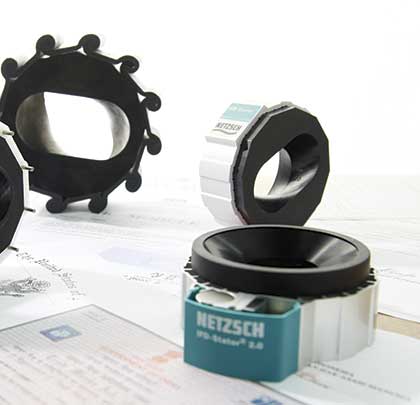One of the processes involved in the mining of gold and silver requires the concentration of mineral slurry—essentially dewatering a mixture of mineral ore and water. Once the mineral slurry is concentrated, it must be pumped to the next phase of processing, normally leaching. A large gold and silver mining operation in northern Mexico was having difficulties optimizing the transport of slurry from their dewatering process due to the unreliable pumps involved in the operation.
CONCENTRATION OF 60 PERCENT SOUGHT BY CUSTOMER
This mining operation was looking to achieve a concentration of 60 percent mineral solids in their slurry. The problem they faced was that the centrifugal pumps transporting the decanted slurry were not able to pump slurry with a concentration above 30 percent This required the mine operator to re-inject water back into the slurry to make it fluid enough to pump, after just expending energy and chemicals to dewater it in the decanting process. In addition, the centrifugal pumps required constant maintenance and a complete change-out after only three months of operation. Slurry with a lower concentration of minerals also requires costly dewatering in the next phase of processing.
Looking for a solution to their problems with centrifugal pumps, the customer tried to replace one with a rotary lobe pump. After only two days of operation, however, the pump housing was destroyed. Netzsch was then contacted through a distributor to help try to solve this difficult production problem.
“When I first learned about the slurry concentration the customer was looking to pump, I wasn’t sure if we could achieve that. However, I knew if we could get the customer to a higher concentration of minerals in the slurry, they would be able to produce more silver and more gold per hour, at a lower cost. So, we decided to take a look,” says Antonio Castilhos, a Netzsch representative.
Netzsch began production trials at the mine with a stock progressing cavity pump. The production testing began with the same slurry mixture of 30 percent mining solids that was currently feeding the centrifugal pumps. Throughout the trials, the water content in the slurry was gradually lowered until the water injection was stopped altogether, and the Netzsch pump proved able to pump slurry of up to 65 percent of minerals solids.
“With the capabilities of the Nemo® pump line to work with extremely difficult materials, we were able to pump the slurry without any injection of water. According to our customer, this level of performance paid for the cost of the pump within the first two or three hours of its operation,” Castilhos says. In part, this was due to the fact that with less water in the slurry, the next processing phase of leaching was able to use a lower volume of aggressive chemicals, providing a major reduction in costs to the customer.

Featured Image: NEMOLAST® S61M
Above: Netzsch NEMO® NM Pump
CUSTOM PROGRESSING CAVITY PUMP SPECIFIED
After the successful trial, final specifications for the production pumps were addressed. For this slurry pumping application, a Nemo® NM Series pump was specified using a tungsten carbide rotor and a NemoLast® S61M with superior abrasion resistance stator. A variable frequency drive was also used to verify the best operating speed during the tests. Pump rotation was initially 189 rpm with a 20 horsepower motor, but after testing, the best rotation was determined to be 130 rpm.
The Netzsch Nemo® NM Pump Series is built with an enlarged stuffing box and tapered suction housing that results in more efficient and trouble free operations, even in difficult applications. The pump is self-priming, has a low shear rate on pumped fluid, and is built for handling highly viscous fluids with solids content.
Today, the mining operation is running three slurry lines with Nemo® progressing cavity pumps and the customer is seeing bottom-line operational and lifecycle cost benefits. Not having to inject water back into the slurry saves on costly chemical processing in the leaching operation. From a lifecycle cost perspective, the mining operation has dramatically lowered the maintenance and replacement costs over the earlier centrifugal pumps. Even with the abrasive nature of the slurry, the rotor and stator in the Netzsch pump last roughly three months before requiring replacement. Finally, with plant uptime improved, more gold and silver ore can be processed, leading to an improvement in overall operational profitability.
About The Author
By Jeffrey Bye, Netzsch Pumps North America
Netzsch Pumps and Systems has served markets worldwide for more than sixty years, providing customized, sophisticated solutions for applications in every industry type. With a workforce of more than 2,000, Netzsch Pumps and Systems is the largest business unit in the Netzsch Group, with annual sales of more than 250 million Euros during the 2015 fiscal year. For more information, visit www.netzsch.com.
________________________________________________________
MODERN PUMPING TODAY, November 2015 Buyers Guide
Did you enjoy this article?
Subscribe to the FREE Digital Edition of Modern Pumping Today Magazine!
![]()


